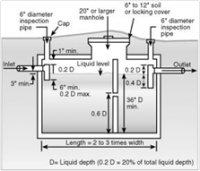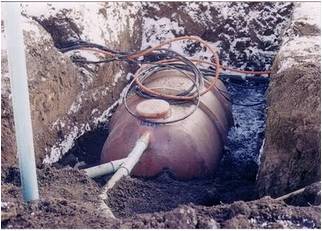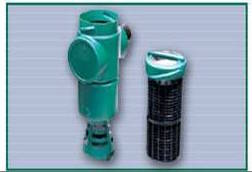Difference between revisions of "Practitioner's Tool / Septic Tanks"
(Created page with "Functionality of a Septic Tank A septic system is a small wastewater treatment system designed to treat and dispose of household s...") |
m (Winona moved page Septic Tanks to Practitioner's Tool / Technology and Operation / Septic Tanks without leaving a redirect) |
(No difference)
| |
Revision as of 19:19, 28 September 2016
A septic system is a small wastewater treatment system designed to treat and dispose of household sanitary waste using a septic tank as the primary component.
The septic tank is the first stage in a private wastewater treatment system. Sewage from the building flows to the septic tank where solids are separated from the wastewater flow. The heavier solids sink to the bottom of the tank to form sludge, while the lighter particles, such as hair and grease, rise to the top to form a scum layer.
Septic tanks use a baffle to separate the tank into compartments. The baffle helps keep the sludge and scum in the first compartment while allowing clarified effluent to pass into the second compartment. A minimum of two compartments are required with the first compartment comprising about two-thirds of the overall tank volume.
Contents
Septic Tank Construction
Septic tanks are commonly constructed from plastic, fiberglass or concrete but never from wood (which decomposes) or steel (which rusts). Concrete septic tanks are either poured in place as a monolithic structure, constructed of hollow blocks that are filled with grout and steel, or precast at a remote casting location. Plastic septic tanks, which are becoming more popular, are manufactured offsite and then distributed for installation. There are many different sizes and shapes of septic tanks available.
A fiberglass septic tank under construction is pictured to the right. Note the bedding material around the tank. This helps protect the tank from rocks that could fall into the hole during the backfilling process. Even concrete tanks should be bedded for added protection against cracking. Regardless which material is used for construction, septic tanks must be sized to accommodate the anticipated wastewater flow and installed correctly. In the past, bottomless or leaching septic tanks were common. These leaching septic tanks are responsible for considerable groundwater contamination. In the Philippines, the latest version of the plumbing code now prohibits leaching septic tanks in favor of sealed tanks with one outlet pipe that is directed to either a sewer system or to further treatment, including on-site leaching systems.
Anatomy of a Septic Tank
Septic tanks have inlet structures, baffles to separate the tank into compartments, outlet structures, and access ports to facilitate desludging.
The inlet and outlet structures are typically open top plumbing tees that direct the incoming waste downwards to reduce the velocity and promote settling of the suspended matter. The outlet pipe draws settled effluent from the middle of the water column in the second compartment, which minimizes the amount of scum and sludge that exits the tank. Plumbing tees are open at the top, allowing sewer gasses to pass from the tank through a plumbing stack in the building. This ventilation system is a critical component, as methane, an explosive gas, is produced through the breakdown of solids in the septic tank. If methane is not allowed to vent properly, it can build up in the tank and cause explosions.
Baffles are constructed into the tank during the manufacture or installation process. They are solid walls in the tank that have transfer openings mid way between the scum layer at the top and the sludge layer at the bottom. These transfer openings may be plastic pipes or simply holes or voids built into the baffle wall. The baffle wall should also have an air space at the top to allow gasses from the second compartment to flow back through the first compartment and out the plumbing stack.
Access ports are openings in the top of the tank that allow for desludging by a vacuum truck. Access ports should be designed with a 50 cm diameter. While an opening this size may seem to indicate that a person is meant to enter the tank, this should never be done. All cleaning must occur from the ground surface. Septic tanks have large openings to allow vacuum truck operators to break up the sludge mass with the hose as they are pumping, which is very difficult to do with a small access port.
NOTE: Septic tanks are confined spaces and present a significant hazard. They must be closed at all times with gas-tight lids that are either locked closed or too heavy for children to lift. Keep children safe around septic tanks. Every year, children die in septic tank accidents that are avoidable.
Installation Procedures
Determining the elevation of the bottom of the septic tank excavation is critical. The builder must ensure that sewage will flow by gravity from the home to the tank inlet, but a sufficiently shallow angle must be maintained to ensure proper residence time in the take to allow for separation of solids from the wastewater. Typically, a 2% slope is required for the pipeline from the house to the tank. That equates to 1/4-inch per foot (approximately 3 centimeters per meter).
The excavation hole should be dug a little deeper than required to achieve proper gravity flow from the house to the inlet. This will allow for bedding material to support the weight of the tank. Bedding material is typically a layer of sand 3 - 6 inches (8 - 14 cm) deep, depending on the type of soil at the bottom of the tank hole. The purpose of bedding material is to protect the tank from rocks puncturing or cracking the tank and to provide a smooth surface that will evenly support the weight of the tank. Septic tanks are very heavy when filled with water, and this weight could break the tank if there are voids beneath it.
Steps to determine the required depth of the tank excavation
- From the plans, identify the height of the tank from the bottom of the outside up to the bottom of the inlet pipe. Record this dimension.
- With a builder's level, determine the elevation of the flow line (bottom of the pipe) of the sewer where it exits the building. Record this elevation. This is a relative elevation that the other measurements will be subtracted from to obtain the tank excavation hole depth.
- Measure the distance from the sewer outlet from the building to the inlet of where the tank will be installed. Multiply this by 1/4-inch per foot (or 3 cm per meter). This will give you the required drop from the house to the tank to ensure proper gravity flow. Record this distance.
- Determine how deep you want the bedding material to be (3-6 inches recommended).
- Add together the tank dimension (dimension from step 1), the pipe drop from the house to the tank (distance from step 3), the bedding material depth (determined in step 4), and subtract from the elevation obtained for the sewer line (elevation from step 2). The result is how deep the tank excavation hole should be relative to the outlet of the sewer pipe.
Use the builder's level frequently to check the depth. You can adjust the depth a little by adding more or less bedding material to get it just right.
Leak Testing
To verify that a septic tank is watertight, leak tests are performed after construction and in conjunction with the back filling procedure. Septic tanks should be filled with water as part of the commissioning process, so it does not hurt to perform the leak test at the same time. Follow these procedures for performing the leak test, and remember, it is best to conduct the test prior to backfilling the tank sides:
- For concrete tanks, ensure that the concrete has hardened for at least 7 days unless a special mixture has been added to quicken hardening. When hardened, fill the tank half full of water.
- Observe for leaks or seeps. You will easily be able to see leaks or wet spots on the concrete from the outside. If you find any leaks, seal them with waterproof concrete or tar. One method for sealing leaky concrete tanks is to pour a kilogram of powdered portland cement into the water in the tank and keep it well mixed. As the water seeps out of the tank, the portland cement particles will seal the hole.
- When you are satisfied that the bottom half of the tank does not leak, backfill around the tank to just below the current level of the water. The weight of the soil around the tank will equalize the weight of the water pushing against the sidewall of the tank.
- Repeat the above steps for the top half of the tank. When the top half is leak free, back fill with the remaining soil. Remember that inlet and outlet pipes from the tank must also be sealed to the tank. Roofing tar or mortar are good products for sealing the holes where the pipes enter and exit the tank.
Visit our page on sewer installation for more information.
Effluent Filters
Effluent filters, pictured to the right, are not standard components of septic tanks and are generally not mandated in local or national codes. Some septic tank installers use effluent filters to keep as much of the suspended solid material as possible in the tank. Effluent filters are cylindrical slotted screens that fit on the outlet tee. The mesh is typically 1/8-inch and helps keep solids from flowing out with the effluent. Effluent filters are service items and will require cleaning at least once per year, more frequently if the tank is undersized or abused. Make sure that if a filter is used, it is installed directly under the tank access port for easy cleaning. Often, filters have inserts with handles, which makes cleaning very easy. Just open the access port lid, pull out the filter insert (wear rubber or latex gloves), and then spray off the filter with a garden hose while directing the water stream back into the tank. Then replace the filter and the access port lid.
There are a number of effluent filter manufacturers; search the Internet for purchasing instructions or for ideas to fabricate your own.
Septic Tank Sizing
In order to properly settle heavy particles and float lighter particles in the wastewater, septic tanks must have sufficient volume. Septic tank volume is typically designed at 2.5 times the maximum daily flow. Use of this formula ensures that there is sufficient retention time to accomplish the separation of solids while allowing bacteria adequate time to degrade the sludge. Proper septic tank sizing also minimizes the frequency of required pumping and cleaning, making them less expensive and easier to maintain.
Determining the average daily flow for a new house or even an existing structure can be difficult. Often, when actual flow metering data is not available, certain assumptions can be made regarding water usage. In the Asia-Pacific region, per capita water use for domestic purposes varies widely depending upon location and affluence. A conservative average of 100 liters per person per day appears to be an acceptable value for planning wastewater systems. Use local knowledge or actual water bills to get more accurate per capita water usage figures.
Work through the example presented below to get an idea of how septic tanks are sized:
- Assume household of 8 persons
- Assume water consumption of 100 liters per person per day
- Size septic tank with 2.5 times daily flow
Answer:
8 persons * 100 liters per day = 800 liters per day
800 liters * 2.5 = 2,000 liters
Therefore, for a household of 8 people, the septic tank capacity should be at least 2,000 liters.
Septic Tank Operation and Maintenance
Pumping - Septic tanks should be pumped when the contained sludge volume exceeds 1/3 to 1/2 of the total tank volume. Typically desludging every 3 to 5 years is sufficient for properly sized tanks.
Chemicals - Detergents and household chemicals in normal amounts do not affect the septic system. Avoid excessive use of chemicals to keep your septic system working properly.
Trash and debris - Avoid discharging non-biodegradable materials such as cigarette butts, disposable diapers, sanitary napkins, plastic, latex or similar materials.
Garbage grinders - Food waste disposers built into sinks significantly increase the load on septic systems. If your house has a disposal, consider increasing the size of your septic tank or pumping more frequently.
Drainage - Keep downspouts, gutters or surface drainage well away from the septic tank. Drainage water can undermine the treatment capabilities of the tank.
Grease - Kitchen grease is especially problematic for plumbing and septic systems. It congeals inside the pipes and can cause clogging. Grease does not break down easily and can exit the tank and clog downstream sewers if allowed to accumulate. Instead of disposing of grease down the drain, capture it in containers and dispose of it in the trash with other food wastes.





